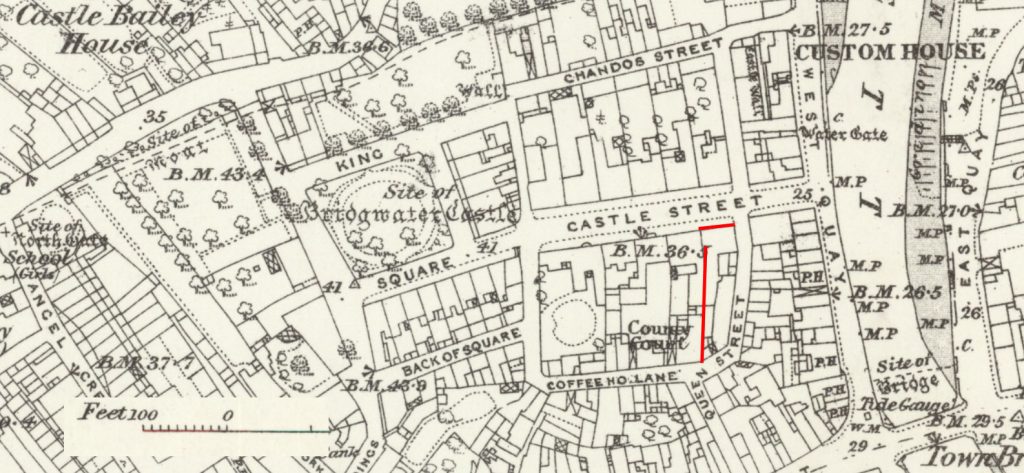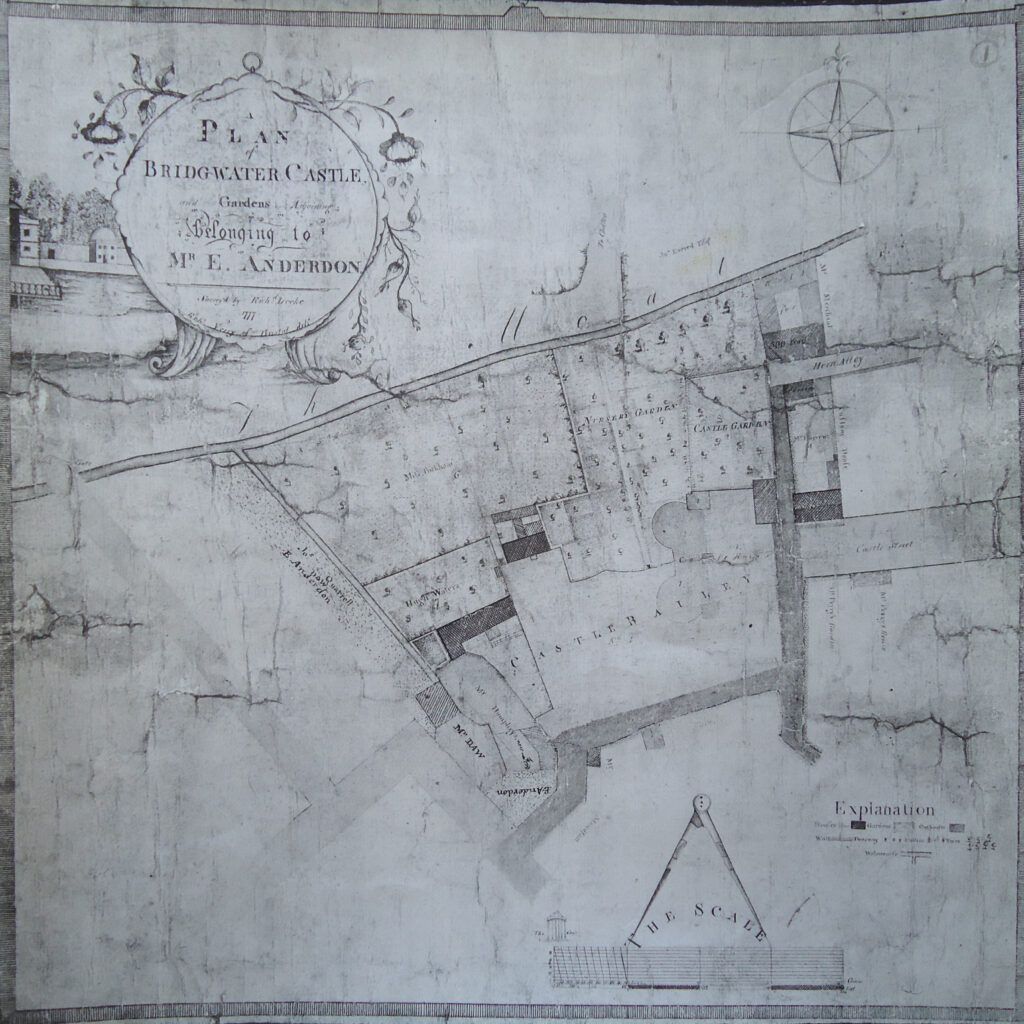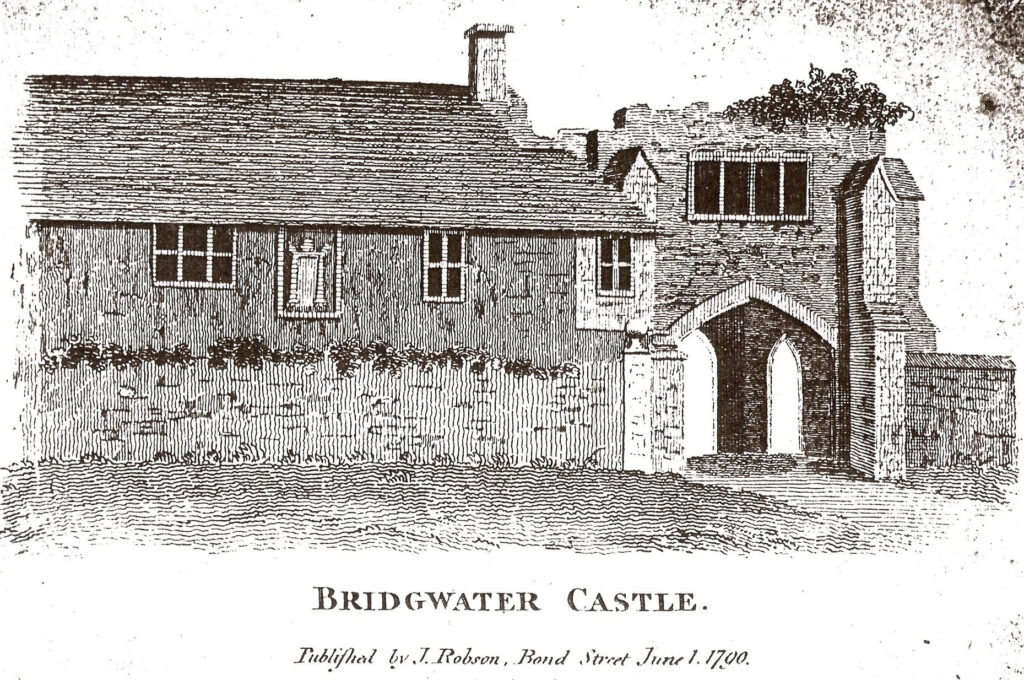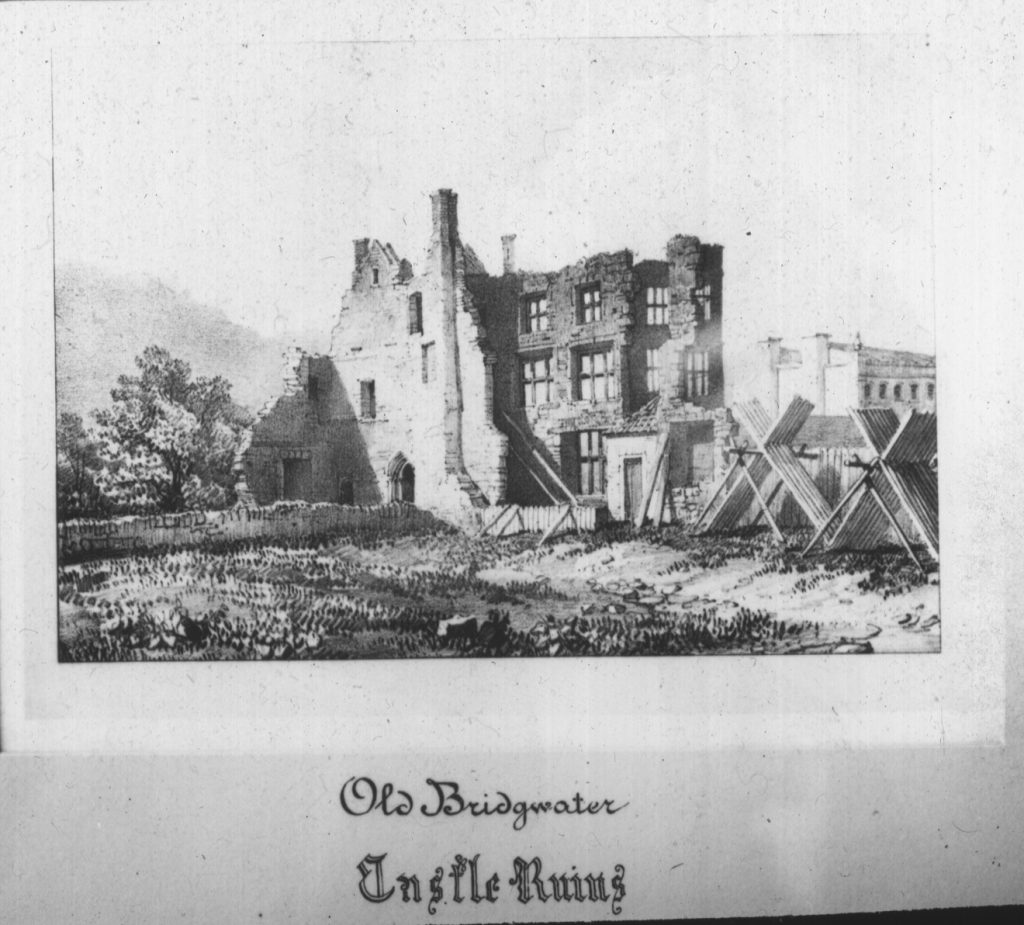These collected Historical Sources Relating to Bridgwater Castle are not yet comprehensive, with more materials to be added over time. If you have any additional primary sources please let us know.
Bridgwater Borough Archives 1200-1366
Bridgwater Borough Archives, 1366-1400To Follow
Bridgwater Borough Archives, 1400-1445To Follow
Bridgwater Borough Archives, 1468-1485 To Follow
1233-1246: Calendar of the Liberate Rolls Vol I, 1226-1240
p.230, September 1st 1233
To the constable of BrugesWalteri- contrabreve to case the hurdles that Richard Wrotham will deliver to him by the King’s order, to be carried to the castle and to be placed safely therein.
p.497, 8th October 1240
To William de Cantilup keeper of Brig’Wauter- to case 15 bucks to be taken in the park of Brig-Wauter and to case them to be salted and carried to the King at London.
Calendar of Liberate Rolls Vol II
p.129, 1242
To the keeper of the castle of Brugewalteri- contrabreve to repair the motte of the keep of the castle, and the turrets which need repair, and put new roofs to the buildings and repair them where necessary, the cost to be credited by the view and testimony of good and lawful men.
p.21, January 23rd 1246
To the constable of the Vastle of Brugeswalteri- Contrabreve to roof the towers in the castle where necessary, to renew the palisade round it and to do other necessary repairs, the cost to be credited by the view and testimony of lawful men.
1322: Calendar of Patent Rolls Vol IV, 1321-1324
p.230, December 25th 1322
Mandate to John de Lortie and John de Say to deliver the castle of Bruggewater and its armour and victuals by indenture to John de Bello Campo of Somerset to whom on 1st December last the King granted custody of the said castle, then in his hands so that he answer for its issues at the exchequer.
1322-6: Calendar of Fine Rolls Vol III 1319-1327
p.94, 15th January 1322
Appointment of John de Lortye and John de Say to take into the king’s hands the castle and town of Bruggewater and to keep the same during pleasure so that he answer for the issue thereof in the chamber.
p.189, December 1st 1322
Commitment during pleas to John de Bello Campo of Somerset of the keeping of the castle of Bridgwater so that he answer for the issues thereof at the exchequer. Order of John de Lortie to deliver the same to him.
p.358, August 19th 1325
Commitment during pleas to Simon de Furneux of the keeping of the Castle of Bruggewauter.
p.420, October 13th 1326
Order to William de Weylond to deliver to Simon de Furneux and John de Say to whom the king committed the Castle of Bridgwater the 40 marks yet remaining with him of the issues of the castle of the time when he had the keeping thereof, to furnish the castle with victuals and other necessaries. Order to the said Simon and John constables of the said castle to receive the said 40 marks from him and to furnish the castle there from with fencible men and other necessaries when need be and if that sum suffice not to supply the deficit from the issues of the castle so that peril arise not to the castle by their default .
1326: Calendar of Memoranda Rolls, 1326-1327
p.111, 15th August 1326
Allowance to John Bello Campo, appointed keeper of BruggeWauter Castle … 11 pounds and 5 shillings spent on wages of 4 men at arms and 18 crossbowmen and archers.
Propter rumores tumoriferos qui venerunt de escapio… Rogeri de MortuoMari, ne idem Rogerus Castrum illud invaderet, eo qued idem castrum partibus Wallie adjacent, et pro eo quod idem castrum non est undique muro nec palicio circumvallatun.
1361: Calendar of Inquisitions Post Mortem Vol X
p.532, April 16th, 34th year of Edward III (1361)
Inquisition taken at Bruggewater, the castle held of the king in chief by knights’ service, but in ruins.
1453 & 55: Bridgwater Borough Archives
Taken from Dilks, T.B., Bridgwater Borough Archives, 1445-1468 (Somerset Record Society, 1948)
p.63 Extract from No. 768, Ralph Gardiner, Common Bailiff. Account for one year. 29th September 1453.
‘Item; for carrying stones from the quay to the castle wall, 2d.’
This entry might suggest that the town was involved with castle maintenence, although it should be noted that they are simply paying for the movement of the materials to the castle wall, not for the execution of repairs. This might suggest a space near the castle wall for keeping building materials before they were needed.
pp.87-88 Extract from No. 786 John Croppe, John ap Howell and Thomas Squyer, churchwardens. Accounts for one year, 29th September 1455.
‘ Therefrom the same reckon for 30 cwt of lead bought, 7 pounds. And paid John Bythesee for carriage of the said lead from Bristol hither, 2s. 8d… And paid for carriage of the said lead from the castle to the church, 3s, 4d.’
Later in the same document:
‘And spent on Baldwin Holcombe and John Weycombe for carriage at the castle at John Pole’s house, 2d.’
Here we see the castle being used as a place of storage for the lead that has arrived from Bristol. Perhaps as a place of strength the castle would serve as a safe place for the valuable lead to be stored before it was used. We also see the suggestion that there are now private dwellings within the castle.
1540: John Leland Visits Bridgwater.
The Castelle sumtyme a right fair and strong Peace of Worke, but now al goyng to mere Ruine, standith harde bynethe the Bridge of the West side of the Haven. Wylliam Bruer the first buildid this Castelle.
Read his full description here.
1565: Bridgwater Port Survey
there is nere adjoynynge unto the key of the saide porte of Brydgewater an olde decayed castell of the quenes majesty within the walles thereof there is a Greene conteyning halfe an Acre of grounde or thereabout the profytt whereof is taken by the Constable of the saide castell whiche is a fytte place for the buyldinge of a Customehouse and wilbe buylded for xl £ so that there may be had convenient stone of the saide decayed castell and tymber out of the Quenes majesties wood called queens wood belonging thereunto
Read the full survey here (external site)
1617: Survey of the Manor of Bridgwater Castle
William Coble the elder and William Coble the younger claymeth to houlde the Castle and the sight contaynying once acre and a grounde called the Queenes Wood contaynying eighteen acres with dwls trees thereon growing for the terme of their two lives by deede Wch They Refuse to Shewe at the yearly rente of xxxi s viid. Margin: 2 lives. 19 acres of pasture. Yearly val x l. Rente xxxi s viii d.
Read the full survey here.
1626: Calendar of State Papers Domestic 1625-1626
p.369, July 7th 1626
Grant to Sir William Whitmore and George Whitmore of the manor of Bridgwater Castle with Haygrove in the county of Somerset.
1634: Calendar of State Papers Domestic for 1643/5
p.502, February 7th 1634/5
Tobias Atkins confesses he made some saltpetre out of the walls of an old castle, lately pulled down by the owner at Bridgewater.
Calendar of State Papers Domestic 1625-1649 (1897) p.501, June 18th 1635, mentions Henry Harvey of Bridgwater, County Somerset, an attorney of the common pleas.
1644: Somerset Heritage Centre DD/SF/14/1/3
Catalogue Description: Authority from Edward Wyndham, The Castle, Bridgwater, to Captain Edward Clarke. Sep 1644: To Clarke and his ensigns to levy the Crown penalty of £5 on inhabitants found to have harboured or set to work enlisted or impressed soldiers.
Transcription:
“Whereby his Majestie hath given order that no Inhabitants whatsoever shall entertain, harbor or sett on works any soulder listed or impressed for his majesties service upon the penaltie of Five pounds to be levyed on his Goods & Chattles, for use of his majesties service I do hereby give Power and authority to Captaine Clearke & his Ensigne William Gatwinke to levye the said some afforesaid on such men as he shall find to have harboured or sett on works any soulders that his ben Enrolled under Captaine Clearke for the use of his Majestie as aforesaid given under my hand and seale at the Castle of Bridgwater thus instant 10th day of September 1644. Edmund Wyndham”
1645: Extracts from Pamphlets on the Storm of Bridgwater
“the enemy being terribly astonished at our approach into the town, there being in the castle many considerable [important] men”
Read the extracts with commentary here.
1647: Joshua Sprigg Anglia Rediviva
“within the town was a castle of indifferent strength”
Read the full account here.
1646-7: (English) Parliamentary Papers
14th August 1646
The garrisons of Bridgwater and Taunton…be forthwith slighted and dismantled…
2nd March 1647
[Repeat Order]…that this house doth adhere to the former order for the disgarrisoning, slighting and dismantling of the works of Bridgwater [note how this mentions the works, i.e. town defences, not the castle].
19th July 1647
…That this house doth agree with the lords, that Bridgwater be degarrisoned and the new works slighted. [Note how this third order specifies the new works, specifically those built during the civil wars, and not the old castle].
1656: Calendar of State Papers Domestic 1656-7 (1883)
p.207, December 23rd 1656
Henry Milles, mayor of Bridgwater to John Lord Desborow, General of the West and MP. Your ready assistance encourages me to represent our cases, we having no help towards the repairing of 120 dwelling houses consumed in the late war, we beg your order for some stones undisposed of, belonging to the late garrison, viz., a small sconce at the foot of the bridge and a wall near the castle 50 feet long and 5 or 6 high, towards the rebuilding of our almshouses, which were utterly demolished; many poor shall bless you for them. Bridgewater 16th December 1656.
Order thereon in council that the mayor and aldermen may take down and carry away the said stones for repairing the almshouses without payment.
1732: Property Details of a House in Castle Street
Extracts from Somerset Heritage Centre DD/S/HNT/2
This indenture made the thirty first day of January Anno 1732 … BETWEEN Richard Coles of Woollavington in the county of Somerset Gent, executor and deviser in trust under the will of John Coles late of Bridgwater in the said county of Somerset merchant and John Coles and James Coles the only sons and also … executors under the will.. on the part and the most nobles James Duke of Chandos (etc) … on the other part
For and in consideration of the sum of five shillings of lawful money etc hath bargained and sold
All that certain plot or parcel of ground belonging to the Capital Messuage commonly called the Castle situate in Bridgwater aforesaid heretofore marked measured out and allotted unto him the said John Coles … in his life time (being the lower most of all the plots of ground on the south side of the new street now built containing forty foot in front towards the said street and about one hundred forty foot backwards from the said street) together with the messuage or tenement and all other erections and buildings erected and built
This property appears to be 7 Castle Street.

1735: Property Details of Castle House
Details of Somerset Record Office DD\X\WBB/266/1 Release of The Castle, Dated the 8th of January 1735.
This document describes the various properties in the castle bailey, including the Castle House, its two gardens, stables and other parcels of land. These seem to be depicted on the 1777 Anderdon Locke map below.
For the details, read more here.
1761: King George III Topographical Illustration

1777 Anderdon Locke Map

1790: The Topographer Illustration of the Watergate

1791: Collinson’s History of Somerset
Collinson’s history contains a number of falsehoods about the castle, The most useful details are: now only a few parts remain; as the water port and some ruins of the lodge. The Ballium is at present used for a deal [timber] yard. Henry Harvey, proprietor of it in 1638, converted the old gatehouse into a mansion of the form of a Roman B.
A full commentary can be read here.
1790s: John Chubb’s Illustrations of Castle House


1877: Memories of George Parker
Somersetshire Archaeological and Natural History Society Proceedings, 1877, Vol 23: Extracts from Mr. Parkers Paper to the Twenty Ninth Annual Meeting pp.46-47
I can carry back my memory to about seventy three years: at that time the site upon which stood the Bridgwater Castle was our play ground as School boys. It is partly built upon now by houses, called Kings Square. Then it was surrounded by wooded palings. At that time the ruins of the old Castle could be seen, also the holes and pits which had been made in digging out its foundations…
Towards the north was a wide ditch, called then the Bailey Ditch, this, no doubt, formed part of the moat… Vaults which are now used as bonded cellars, near the present Custom House, it is supposed, communicated with the castle from the river, as between the Custom House and Castle Street places have been seen, (and I believe even now some trace of them is found,) that opened into those vaults….
We can also trace remnants of the wall which still remain towards the west, leading to Dr. Morgans School, and which formed part of the [town] defences; and on the east end of the town, near where Barclay Street stands, were very high mounds of earth, in which were removed for building purposes, the workmen found human bones, bullets, swords, and other military weapons.
More on George Parker can be read about here.
Parker’s memories can be taken as the last of the Historical Sources Relating to Bridgwater Castle as after him we only have secondary accounts. However archaeology further contributes to this story.
